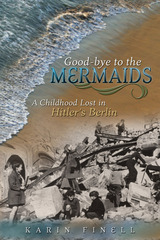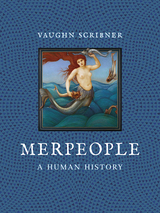3 books about Mermaids

Fan Phenomena
Mermaids
Edited by Matthieu Guitton
Intellect Books, 2016
Disney’s Princess Ariel would give anything to be “where the people are,” but little does she know there’s an ever-growing fan base of humans dying to be down in the ocean where she is. Movies like the Little Mermaid and Pirates of the Caribbean have sparked the interest of newer generations of mermaid fans, but our enchantment with these mythical creatures of the sea goes back for centuries. Fan Phenomena: Mermaids takes a deep dive into these fascinations and the cultural creations that mermaids inspire among fans of all ages.
Mermaids, and merfolk more generally, are everywhere you look. Merfolk devotees march in themed parades and practice mermaid-ing—swimming with a mermaid tail. There’s mermaid fiction and mermaid virtual reality; mermaid art and #mermaid trends. You may not know it, but transgenerational merfolk fan communities stretch around the world—from sea to shining sea. And their popularity is only growing.
In Fan Phenomena: Mermaids, Matthieu Guitton assembles a star-studded cast of scholars and popular culture insiders to decode the mermaid phenomenon. The book explores how merfolk have evolved in popular culture and what it is that grants them their privileged status among fantasy creatures. Illustrated throughout with fan photographs and stills from a plethora of films and TV shows, this new addition to the Fan Phenomena series promises to both fascinate and delight readers—earthbound and ocean-going alike.
Mermaids, and merfolk more generally, are everywhere you look. Merfolk devotees march in themed parades and practice mermaid-ing—swimming with a mermaid tail. There’s mermaid fiction and mermaid virtual reality; mermaid art and #mermaid trends. You may not know it, but transgenerational merfolk fan communities stretch around the world—from sea to shining sea. And their popularity is only growing.
In Fan Phenomena: Mermaids, Matthieu Guitton assembles a star-studded cast of scholars and popular culture insiders to decode the mermaid phenomenon. The book explores how merfolk have evolved in popular culture and what it is that grants them their privileged status among fantasy creatures. Illustrated throughout with fan photographs and stills from a plethora of films and TV shows, this new addition to the Fan Phenomena series promises to both fascinate and delight readers—earthbound and ocean-going alike.
[more]

Good-bye to the Mermaids
A Childhood Lost in Hitler's Berlin
Karin Finell
University of Missouri Press, 2006
Good-bye to the Mermaids conveys the horrors of war as seen through the innocent eyes of a child. It is the story of World War II as it affected three generations of middle-class German women: Karin, six years old when the war began, who was taken in by Hitler’s lies; her mother, Astrid, a rebellious artist who occasionally spoke out against the Nazis; and her grandmother Oma, a generous and strong-willed woman who, having spent her own childhood in America, brought a different perspective to the events of the time. It tells of a convoluted world where children were torn between fear and hope, between total incomprehension of events and the need to simply deal with reality.
In one of the relatively few recollections of the war from a German woman’s perspective, Finell relates what was for her a normal part of growing up: participating in activities of the Hitler Youth, observing Nazi customs at Christmas, and once being close enough to the Führer at a rally to make eye contact with him. She tells of how she first became aware of the yellow star that Jews were forced to wear, and of being asked to identify corpses from a bombed apartment house. She also depicts the lives of people tainted by Hitler’s influence: her half-Jewish relatives who gave in to the strain of trying to remain unnoticed; a favorite aunt who was gassed because she was old and had broken her hip; and a friend of the family who was involved in the abortive putsch against Hitler and hanged as a traitor.
When American and British forces intensified air raids on Berlin in 1943, Finell observed the stoical valor of women during the bombings, firestorms, and mass evacuations. Not yet a teenager, she witnessed the battle for Berlin and the mass rapes perpetrated by conquering Russian and Mongolian troops. Order was restored after the American and British troops arrived. The Marshall Plan jump-started an economic recovery for West Germany, provoking the Russians to blockade Berlin. From 1948 to 1949 the Americans and British kept Berlin’s residents alive with the airlift. But even though food was flown in, the people of Berlin continued to go hungry. Deprivation forced Berliners to look inward and face their collective guilt as they withstood the threat of Soviet occupation during these postwar years.
This eloquent and touching story tells how a decent people were perverted by Hitler and how a young girl ultimately came to recognize the father figure Hitler for the monster he was. From a time of innocence, Karin Finell takes readers along a nightmarish journey in which fantasies are clung to, set aside, and at last set free. Good-bye to the Mermaids presents us with the revelation that human beings can survive such times with their souls intact.
[more]

Merpeople
A Human History
Vaughn Scribner
Reaktion Books, 2024
A wide-ranging, beautifully illustrated history of mermaids and mermen from the classics to cosplay.
People have been fascinated by merpeople and merfolk since ancient times. From the sirens of Homer’s Odyssey to Hans Christian Andersen’s The Little Mermaid and the film Splash, myths, stories, and legends of half-human, half-fish creatures abound. In modern times “mermaiding” has gained popularity among cosplayers throughout the world. In Merpeople: A Human History, Vaughn Scribner traces the long history of mermaids and mermen, taking in a wide variety of sources and using 117 striking images. From film to philosophy, church halls to coffee houses, ancient myth to modern science, Scribner shows that mermaids and tritons are—and always have been—everywhere.
People have been fascinated by merpeople and merfolk since ancient times. From the sirens of Homer’s Odyssey to Hans Christian Andersen’s The Little Mermaid and the film Splash, myths, stories, and legends of half-human, half-fish creatures abound. In modern times “mermaiding” has gained popularity among cosplayers throughout the world. In Merpeople: A Human History, Vaughn Scribner traces the long history of mermaids and mermen, taking in a wide variety of sources and using 117 striking images. From film to philosophy, church halls to coffee houses, ancient myth to modern science, Scribner shows that mermaids and tritons are—and always have been—everywhere.
[more]
READERS
Browse our collection.
PUBLISHERS
See BiblioVault's publisher services.
STUDENT SERVICES
Files for college accessibility offices.
UChicago Accessibility Resources
home | accessibility | search | about | contact us
BiblioVault ® 2001 - 2024
The University of Chicago Press









